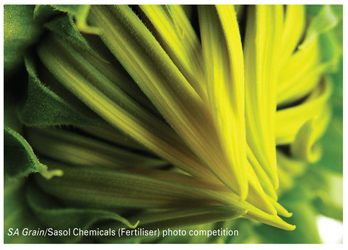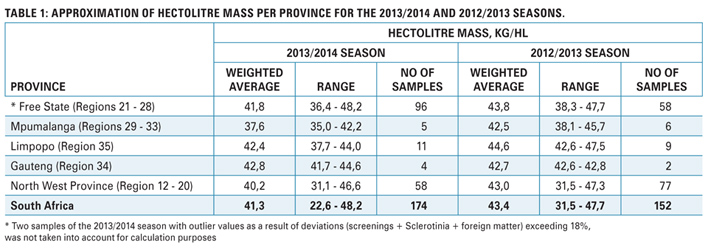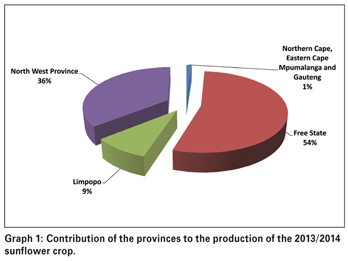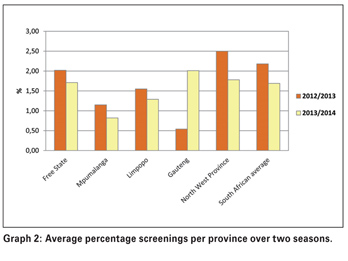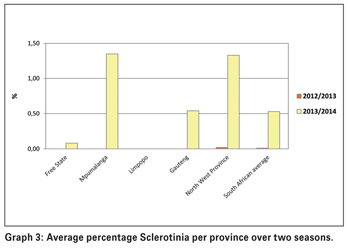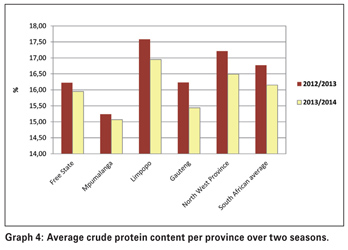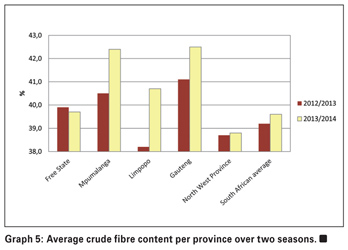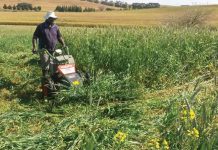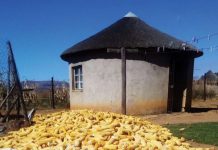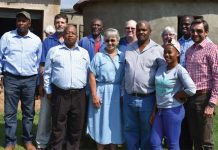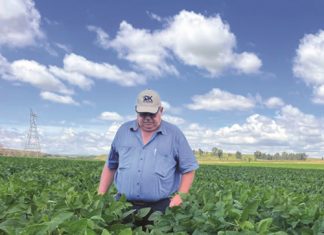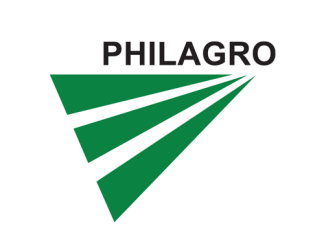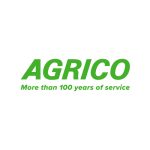October 2015
JOLANDA NORTJÉ, manager: Laboratory, The Southern African Grain Laboratory NPC
During the 2014 harvesting season, a representative sample of each delivery of sunflowers at the various silos was taken according to the prescribed grading regulations. Of the 176 samples analysed for the purpose of this second annual survey, 82% (145) were graded as grade FH1, and 31 of the samples were downgraded to class other sunflower seed (COSF).
This percentage of FH1 samples compares well with the 80% of the 2012/2013 season.
The major factors responsible for downgrading 68% of the 31 samples mentioned above, were the percentages screenings or Sclerotinia and as a result the percentage collective deviations exceeding the maximum permissible deviations of 4% (both screenings and Sclerotinia) and 6% respectively.
Gauteng (four samples) reported the highest weighted average percentage screenings namely 2,01%, followed by the North West Province (N = 58) and Free State (N = 98) with 1,78% and 1,71% respectively. Mpumalanga (five samples) reported the lowest average percentage screenings of 0,82%.
Sclerotinia was not observed on any of the eleven samples from Limpopo. The samples from the Free State had the lowest weighted average percentage of Sclerotinia, namely 0,08%. Mpumalanga had the highest percentage of 1,35%, closely followed by the North West Province with 1,33%. During the 2012/2013 season, Sclerotinia was observed in the North West Province (weighted average of 0,02%) and one region in the Free State (average 0,01%).
In the 2012/2013 season, Sclerotinia was found in only four samples, three from the North West Province and one from the Free State. The percentages of Sclerotinia present were well below the maximum permissible level of 4%.
The highest weighted percentage foreign matter (1,63%) was reported for the four Gauteng samples. The Free State and North West Province averaged 1,46% and 1,35% respectively. The lowest average percentage was found in Limpopo at 0,89%.
Although hectolitre mass does not form part of the grading regulations for sunflower seed in South Africa, an approximation of the hectolitre mass of South African sunflower seeds over the last two seasons, is provided in Table 1 for information purposes.
The g/1 L filling weight of sunflower seed was determined by means of the Kern 222 apparatus. The hectolitre mass was extrapolated by means of the following formulas obtained from the Test Weight Conversion Chart for Sunflower Seed Oil of the Canadian Grain Commission: y = 0,1936x + 2,2775 (138 to 182 g/0,5 L) and y = 0,1943x + 2,1665 (183 to 227 g/0,5 L).
After consultation with the industry, it was decided to report the crude protein, fat, fibre and ash components as a percentage (g/100 g) on an “as received” or “as is” basis. The average crude protein content of the 2013/2014 season was 16,15%, 0,62% lower than the 16,77% of the previous season. Limpopo showed the highest weighted average crude protein content of 16,95% and Mpumalanga the lowest, with 15,07%. The North West Province and the Free State had protein contents of 16,49% and 15,95% respectively.
The average crude fat percentage increased from 39,2% in 2012/2013, to 39,6% this season. Gauteng had the highest weighted average crude fat content of 42,5%. The lowest average fat contents were observed in the North West Province (38,8%) and the Free State (39,7%).
The weighted average percentage of crude fibre increased slightly from 20% to 20,2% and varied between 18,6% in Limpopo and 20,6% in the North West Province. The weighted average ash content is comparable, 2,66% this season and 2,54% last season, varying 0,16% on average between provinces (Gauteng the lowest and the Free State the highest).
Detailed results of this survey as well as that of the previous season are available on the SAGL website (www.sagl.co.za). The annual crop quality reports in PDF-format are also available for download from the website.
With gratitude to the Oil and Protein Seed Development Trust for financial support of these annual surveys and to the members of Agbiz Grain and DAFF inspectors for providing the samples.
Publication: October 2015
Section: Relevant



